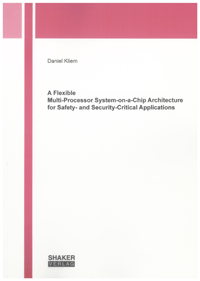
Shop : Details
Shop
Details

October 2013
Daniel Kliem
A Flexible Multi-Processor System-on-a-Chip Architecture for Safety- and Security-Critical Applications
Modularization is a common design pattern in safety- and security-critical embedded software designs. It is mainly motivated by complexity reduction but also allows for effort and cost reduction during development. Domain segregation is a key concept to support such system partitioning. In contrast to strict isolation, segregation allows for communication between segregated components.
This thesis presents a concept of a robust, safe, secure, and efficient architecture with segregation support that is well prepared for certification. Moreover, it deals with aspects of prototype realization on an Field Programmable Gate Array (FPGA) platform. The goal is to host different safety and security critical functions with as few hardware components as possible: the System-on-a-Chip (SoC) approach.
Software solutions, i. e., operating systems with time and space partitioning, are state-of-the-art approaches to handle segregation. As an alternative to pure software solutions, and to circumvent their particular drawbacks, a novel SoC architecture is proposed.
The architecture offers hardware enforced segregation and is completely transparent to software applications. Since it targets reconfigurable platforms, the architecture is flexible and can be tailored to application specific needs at design time.
This approach follows the recent trend of chip-multiprocessing. Instead of focusing solely on software partitioning, the architecture segregates whole computer systems on a single chip. Segregation is achieved with a hierarchical connection of memory busses by secure bus bridges. Different bridge designs are evaluated. Special attention is paid to performance evaluation and avoidance of temporal conflicts. The architecture is evaluated by dedicated bus observers using simulation and hardware prototypes. It is finally able to run multiple isolated off-the-shelf Linux systems.
This thesis presents a concept of a robust, safe, secure, and efficient architecture with segregation support that is well prepared for certification. Moreover, it deals with aspects of prototype realization on an Field Programmable Gate Array (FPGA) platform. The goal is to host different safety and security critical functions with as few hardware components as possible: the System-on-a-Chip (SoC) approach.
Software solutions, i. e., operating systems with time and space partitioning, are state-of-the-art approaches to handle segregation. As an alternative to pure software solutions, and to circumvent their particular drawbacks, a novel SoC architecture is proposed.
The architecture offers hardware enforced segregation and is completely transparent to software applications. Since it targets reconfigurable platforms, the architecture is flexible and can be tailored to application specific needs at design time.
This approach follows the recent trend of chip-multiprocessing. Instead of focusing solely on software partitioning, the architecture segregates whole computer systems on a single chip. Segregation is achieved with a hierarchical connection of memory busses by secure bus bridges. Different bridge designs are evaluated. Special attention is paid to performance evaluation and avoidance of temporal conflicts. The architecture is evaluated by dedicated bus observers using simulation and hardware prototypes. It is finally able to run multiple isolated off-the-shelf Linux systems.
Keywords: FPGA; SoC; Multi-Processor; Safety; Security; Memory Busses
Available online documents for this title
You need Adobe Reader, to view these files. Here you will find a little help and information for downloading the PDF files.
Please note that the online documents cannot be printed or edited.
Please also see further information at: Help and Information.
Please also see further information at: Help and Information.
| Document |  | Abstract | ||
| Type |  | |||
| Costs |  | free | ||
| Action |  | Download the file | ||
| Document |  | Document | ||
| Type |  | |||
| Costs |  | 37,35 € | ||
| Action |  | Purchase in obligation and download the file | ||
| Document |  | Table of contents | ||
| Type |  | |||
| Costs |  | free | ||
| Action |  | Download the file | ||
User settings for registered online customers (online documents)
You can change your address details here and access documents you have already ordered.
User
Not logged in
Export of bibliographic data
Shaker Verlag GmbH
Am Langen Graben 15a
52353 Düren
Germany
Am Langen Graben 15a
52353 Düren
Germany
Mon. - Thurs. 8:00 a.m. to 4:00 p.m.
Fri. 8:00 a.m. to 3:00 p.m.
Fri. 8:00 a.m. to 3:00 p.m.
Contact us. We will be happy to help you.

